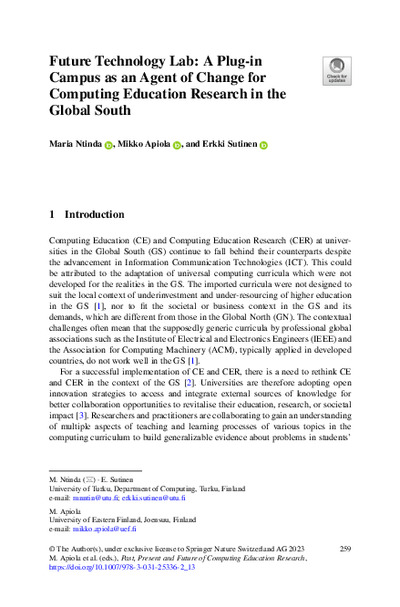Future Technology LabA Plug-in Campus as an Agent of Change for Computing Education Research in the Global South
|
 |
 Diese Seite wurde seit 2 Jahren inhaltlich nicht mehr aktualisiert.
Unter Umständen ist sie nicht mehr aktuell.
Diese Seite wurde seit 2 Jahren inhaltlich nicht mehr aktualisiert.
Unter Umständen ist sie nicht mehr aktuell.
 Zusammenfassungen
Zusammenfassungen
 Computing Education Research (CER) has experienced substantial growth and its demand continues to expand. The University of Turku, in the Global North has formed a partnership with the University of Namibia, in the Global South to reform or contextualise Computing Education (CE) and CER among many initiatives to improve the relevance of CER through the establishment of the Future Technology Laboratory (FTLab). An analysis of the FTLab was applied using Design Science Research. Lessons learned, and how the initial goal of the FTLab could be improved in ways that require the rethinking of CE and CER in the context of the Global South to pioneer a novel CER approach locally and globally are presented. A Design Reality Gap framework was applied to show how to inform the process of making CER more relevant in each context, in our case by the FTLab plug-in campus. While progress has been made in CER in Namibia, challenges in realising the goal of the FTLab persist. This study contributes to the literature on how to reform or contextualise CER to improve its relevance in developing countries.
Computing Education Research (CER) has experienced substantial growth and its demand continues to expand. The University of Turku, in the Global North has formed a partnership with the University of Namibia, in the Global South to reform or contextualise Computing Education (CE) and CER among many initiatives to improve the relevance of CER through the establishment of the Future Technology Laboratory (FTLab). An analysis of the FTLab was applied using Design Science Research. Lessons learned, and how the initial goal of the FTLab could be improved in ways that require the rethinking of CE and CER in the context of the Global South to pioneer a novel CER approach locally and globally are presented. A Design Reality Gap framework was applied to show how to inform the process of making CER more relevant in each context, in our case by the FTLab plug-in campus. While progress has been made in CER in Namibia, challenges in realising the goal of the FTLab persist. This study contributes to the literature on how to reform or contextualise CER to improve its relevance in developing countries. Anderswo finden
Anderswo finden
 Volltext dieses Dokuments
Volltext dieses Dokuments
 |  Future Technology Lab: A Plug-in Campus as an Agent of Change for Computing Education Research in the Global South: Artikel als Volltext @ Springer ( Future Technology Lab: A Plug-in Campus as an Agent of Change for Computing Education Research in the Global South: Artikel als Volltext @ Springer ( : :  , 578 kByte; , 578 kByte;  : :  ) ) |
 Anderswo suchen
Anderswo suchen 
 Beat und dieses Kapitel
Beat und dieses Kapitel
Beat hat Dieses Kapitel während seiner Zeit am Institut für Medien und Schule (IMS) ins Biblionetz aufgenommen. Er hat Dieses Kapitel einmalig erfasst und bisher nicht mehr bearbeitet. Beat besitzt kein physisches, aber ein digitales Exemplar. Eine digitale Version ist auf dem Internet verfügbar (s.o.). Aufgrund der wenigen Einträge im Biblionetz scheint er es nicht wirklich gelesen zu haben. Es gibt bisher auch nur wenige Objekte im Biblionetz, die dieses Werk zitieren.












 Biblionetz-History
Biblionetz-History